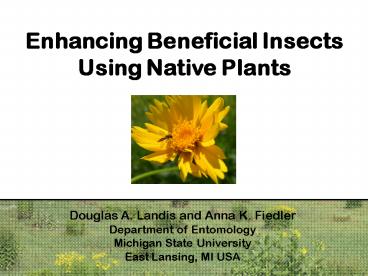Enhancing Beneficial Insects - PowerPoint PPT Presentation
1 / 26
Title:
Enhancing Beneficial Insects
Description:
Flower hue, chroma (S 2000 Fiber optic spectrophotometer) Floral area/ m2 plot (Scion image) ... Vacuum-sampled all flowers for 30 seconds during 3 weeks of ... – PowerPoint PPT presentation
Number of Views:393
Avg rating:3.0/5.0
Title: Enhancing Beneficial Insects
1
Enhancing Beneficial Insects Using Native Plants
Douglas A. Landis and Anna K. Fiedler Department
of Entomology Michigan State University East
Lansing, MI USA
2
Introduction to beneficial insects Role of plants
in enhancing beneficial insects Research on
native plants Implications for agricultural
landscapes
3
Beneficial Insects
- Pollinators
- -Honey bees
- -Native bees
- Natural enemies
- -Predators
- -Parasitoids
Arthropod-Mediated Ecosystem Services
(AMES) 57 B/y 3.1 B/y pollination 4.5 B/y
pest suppression Losey Vaughan BioScience,
2006
4
Conservation Biological Control
- Natural enemies may require
- Food
- Nectar
- Pollen
- Sap, honeydew
- Alternate host/prey
- Shelter
5
Habitat Management
- Widely used plants in habitat management
- Dill Anethum graveolens
- Coriander Coriandrum sativum
- Buckwheat Fagopyrum esculentum
- Alyssum Lobularia maritima
- Faba bean Vicia faba
- Native plants
- Provide ecosystem services
- Enhance native biodiversity
- Restoration of imperiled habitats
- Habitat permanency (perennials)
6
Assess natural enemy attractiveness to native
plants Determine important plant characteristics
7
Methods Plot Establishment
2004
2003
2005
- - 43 native perennials,
- 5 recommended non-native annuals
- RCBD, 5 replicates
- 245 total 1m2 plots
- 2 hectares
8
Methods Plant Sampling
Plant characteristics
Week of peak bloom Flower height Corolla depth,
width (Spot imaging system) Flower hue, chroma
(S 2000 Fiber optic spectrophotometer) Floral
area/ m2 plot (Scion image)
9
Methods Insect Sampling
Vacuum-sampled all flowers for 30 seconds during
3 weeks of peak bloom (Stihl BG55)
Insects identified to family, counted (77,883
total)
- Sampled grass areas between plots weekly
10
2005 Bloom Period
11
2005 Bloom Period
s
s
s
s
s
s
s
p
12
2005 Bloom Period
13
Bee Abundance at Native Plants
early
middle
late
Tuell et al. Environ. Entomol. In press
14
Natural Enemies Collected at Flowers
30
25
2005 data
15
Early Season May mid June
http//native plants.msu.edu
2005 data
16
Early Season May mid June
2005 data
17
Early Season May mid June
2005 data
2005 data
18
Mid Season July mid August
2005 data
2005 data
19
Late Season mid August September
2005 data
20
http//nativeplants.msu.edu
21
- Not
- Flower height
- Corolla depth, width
- Flower color/saturation
- Natural enemies and bees both like
- Large floral area relative to time of season
22
Win-Win Scenarios
- On-farm conservation
23
Win-Win Scenarios
- Biofuel production
24
Broader Implications
- Consistent with conservation goals
- Soil and water
- Biodiversity
- Ecosystem services
- Rural Sustainability
- Native Plant Nurseries
- Agrotourism
25
Learn More
- Enhancing Beneficial Insects with Native Plants
http//nativeplants.msu.edu
26
Acknowledgements
Funding Support
Research collaborators Bill Schneider Gene
Vogel, Richard Stuckey Julianna Tuell, Rufus
Isaacs USDA NRCS Ingham County Soil
Conservation District MSU IPM Identification
support Gary Parsons Dr. Debra Trock Landis
lab Chris Sebolt, Jeff Evans, Mary Gardiner,
Alejandro Costamagna
USDA Sustainable Agriculture Special Grant
- Undergraduate Research Assistants
- Jessica Steffen, Dawn Richards, Emily Knoblock,
Bob McDonald, Alissa Berro, Matt Wood, Chuck
Stahlman, Charlie Richards, Tara Lehman, Mike
Wayo, and Ryan Alderson.
http//nativeplants.msu.edu































